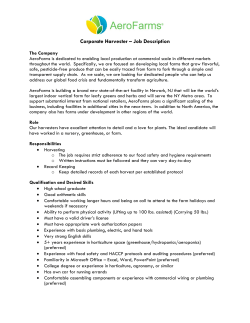
Changes in Farmworker Characteristics
Changes in Farmworker Characteristics Susan Gabbard, Trish Hernandez, Sarah MacDonald, Daniel Carroll Farm Labor and the ALRA at 40 April 17, 2015 The views presented are those of the speaker and not the Department of Labor Overview • Who are California farmworkers and how do they differ from farmworkers in the rest of the U.S.? Their demographics Where they come from Work patterns Farm job characteristics • How has the population changed over the last two decades? About the National Agricultural Workers Survey • National survey of crop workers started in 1989; the only source of reliable information on crop worker demographics. • Random sample survey of 1,500-3,000 workers annually. • 56,976 farmworkers interviewed from 1989 to 2012 (19,720 of them were in California). • Establishment survey – find workers at work. • Limited regional coverage and no local numbers. • The data is grouped in two-year intervals to get a large enough sample size for comparisons. • Three time-periods will be compared: 1989-1990, 1999-2000, and 2011-2012. These time points are referred to as 1990, 2000, and 2012 throughout the talk. • Some of the findings reported have a larger margin of error due to the smaller sample size and are marked with a superscript “a”. How Have the Characteristics of the California Farm Labor Force Changed? California Farm Labor Force Mostly Immigrant Percent of Workers Who Were Foreign-Born 93% 1990 51% 97% 2000 75% 95% 2012 59% 0% 20% 40% California 60% Rest of U.S. Source: National Agricultural Workers Survey 80% 100% In 1990, California Farmworkers : • Were work authorized 91% • Few unauthorized 9% • Highly migrant 41% • International migrants 27% • Had families 83% and lived with them 64% Source: National Agricultural Workers Survey The 1990s Saw an Influx of Newcomers Labor force changed: • Younger; average aged declined from 35 to 32 years • More migrant 51% • More singles 41% • Unaccompanied increased from 36% to 63% Percent of California Workers Who Were Newcomers 60% 40% 29% 20% 2% 0% 1990 Source: National Agricultural Workers Survey 2000 After 2000 Decline in Newcomers and Indigenous Among California Farmworkers Percent of California Workers Identified As Indigenous Percent of California Workers Who Were Newcomers 60% 60% 40% 40% 29% 28% 23% 20% 20% 12% 10% a 3% 2% 0% 0% 1990 2000 2012 2006 Source: National Agricultural Workers Survey 2008 2010 2012 Return of Older Workers with Families In 2012, California farmworkers were: • Older; average age 37 • Had families 75% • Single 25% • Accompanied by family at the work location 64% • Women 28% Fewer California Farmworkers Migrated On An Annual Basis Percent of California Farmworkers Who Were Migrant 60% 51% 41% 40% 20% 11% 0% 1990 2000 Source: National Agricultural Workers Survey 2012 International Migrants Crossing the U.S.-Mexico Border to Work in California 27% 1990 46% 2000 7% 2012 Map source: http://travel.state.gov/content/dam/tsg-global/country-maps/mx-map.gif Sending Regions Sending Regions 100% 80% 60% 40% 20% 0% 1992 West Central Mexico Rest of Mexico 2000 2012 Pacific South Mexico Central America California Farm Labor Force Now Mostly Unauthorized Percent of Workers Who Were Unauthorized 9% 1990 13% 63% 2000 50% 63% 2012 41% 0% 20% 40% California Rest of U.S. Source: National Agricultural Workers Survey 60% 80% Increased Educational Attainment Among California Farmworkers, But Less Than Rest of U.S. Percent of Workers With More Than a 6th Grade Education 34% 1990 62% 32% 2000 49% 46% 2012 64% 0% 20% 40% California Rest of U.S. Source: National Agricultural Workers Survey 60% 80% How Have Their Jobs and Work Patterns Changed? California Farmworkers Employment Patterns Average number of years doing US farm work Workers having one employer in past year Average hours worked per week 1990 2012 11 years 14 years 37% 72% 39 hours 46 hours Average number of weeks worked 31.5 weeks 40 weeks in farm work Source: National Agricultural Workers Survey California Farmworkers Compensation 1990 2012 Paid by the piece 16% 9% Live in employer provided housing 16% 6% Farmworker paid for all or some equipment used at work 32% 6% Nominal wage $5.58 $9.06 Source: National Agricultural Workers Survey California Farmworkers Health and Safety Employer provided clean drinking water every day Employer provided a toilet every day Employer provided water to wash hands every day In last 12 months, employer provided training in safe use of pesticides 1990 2012 NA 98% 91% 99% 83% 100% NA 89% Source: National Agricultural Workers Survey The End Contact information: Susan Gabbard sgabbard@jbsinternational.com Daniel Carroll carroll.daniel.j@dol.gov
© Copyright 2025








